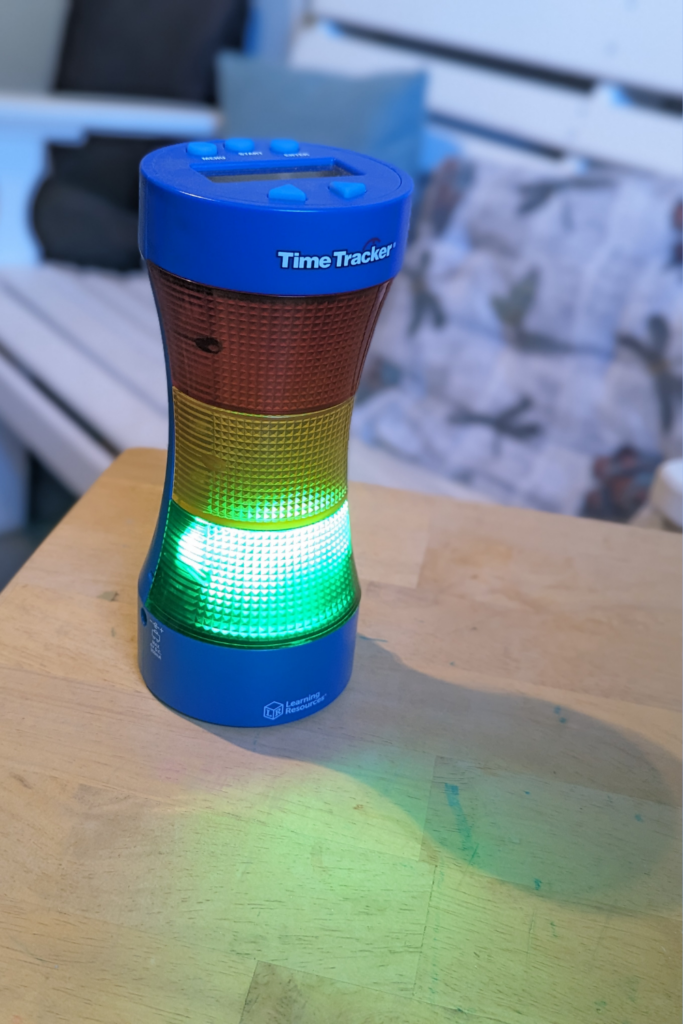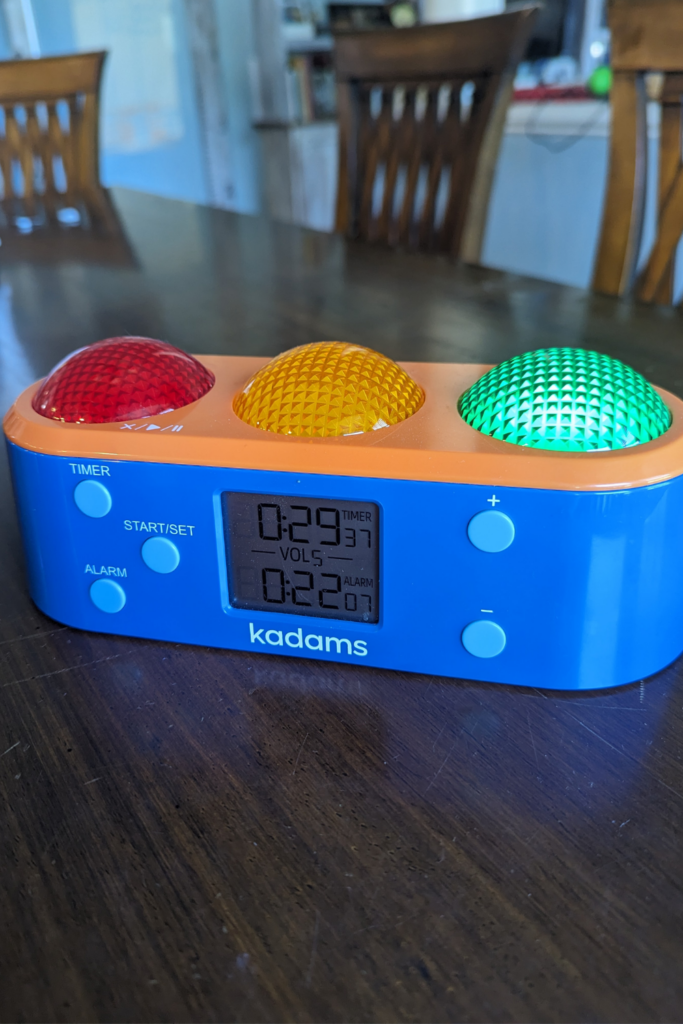
One of the most helpful techniques for parenting is, in my opinion, using countdowns. While I love the simplicity of 1-2-3 Magic, a commonly recommended discipline method, I’m not talking about using countdowns for discipline. I’m talking about using countdowns to let children know what’s happening.
While we sometimes do this for major events like Christmas (ie. an Advent Calendar) or a trip to Disney, we often don’t use this technique routinely.
I’m going to talk a little about why I love using countdowns and how it can be helpful for kids, including neurodivergent kids.
Please make an appointment through the patient portal or call 443-300-6094 if you’re interested in pursuing therapy in Howard County, Maryland through Happy Honeysuckle Healing Center. If you have a psychiatric or medical emergency, please contact 911 or go to your nearest emergency room.
This blog is for educational purposes only. This information is best case scenario, at least within the scope of my knowledge and experience at the time I write the post. Not only does everyone have different approaches to parenting and life- and my way may not be your cup of tea, but also- I am not perfect, nor do I want anyone to imagine that I am. Despite being a therapist and having a whole host of really cool techniques for all the mental health related things, I am constantly learning and trying to do better.
I’m hoping that this blog can help you. When we share what works for us, we can help others develop their own toolkit for improving their mental health.
Countdowns for Transitions
Kids who are neurodivergent often struggle with change, particularly abrupt change. I think most humans struggle with this, regardless of their age. Even if many of us can bounce back from sudden change, it still isn’t pleasant to have your boss barge in while you’re still caffeinating on Monday morning, just to announce that your entire building will be moving next week- and “Hey! You! Stop what you’re doing and start packing immediately.” I think most of us would struggle with this.
And yet, when we interact with children and adolescents, we often don’t give them the same respect that we would like to have our employer give us. In other words- sometimes we expect more from kids than we would expect from an adult.
An example of this would be the transition from home to school. We say, “Time to go, get your shoes on and get your backpack! NOW! Oh my goodness, you haven’t brushed your teeth yet?! RUN! GO! DO IT!” Or, when we want to leave the playground, “It’s time to leave NOW, let’s go.”
Children, particularly neurodivergent children, are still developing executive functioning, and time management is one of those skills. Children and adults with ADHD also often have time agnosia: they are very poor judges of how much time has passed. While you could ask a neurotypical person how long has passed and they could give you an approximately accurate answer, people with time agnosia are often far from accurate.
I struggle with time agnosia, and there are times when 15 minutes feels like hours and other times when I look up and OH NO, I’M LATE! As someone who has no sense of time, I’ve learned to use timers, the calendar on my phone, and alarms to keep myself on track.
But even a neurotypical child is going to have poor time management- it’s not an early developmental skill.
So when you’re getting tired after sitting at the playground for the past hour, your children may not know how long it has been. They likely aren’t thinking, “It’s been about an hour, I should probably should plan to wrap up soon and say goodbye to my friends.” When you call them and say it’s time to leave NOW, this can throw them off… they weren’t expecting this and it may feel abrupt to them. They may feel rushed, frustrated, or angry.
Using a countdown method allows kids to prepare mentally for transitions and tends to lead to smoother transitions for the grownups as well. There tends to be less arguing or dragging of feet. Is it going to be perfect? No. But it can be helpful.
I’ve used this with my own children, but occasionally forget. I see a night and day difference in their level of resistance and cooperation when I forget.
What Do Transition Countdowns Look Like?
As parents, we can help our children learn to manage their time, and give them the skills necessary to transition to adulthood. When they’re young, it’s helpful to offer countdowns. As they mature, you can help engage them in the process so they learn to apply these skills. A countdown isn’t “10, 9, 8, 7, 6, 5, 4, 3, 2, 1, BLASTOFF!” It’s a matter of checking in with them two or three times leading up to a transition.
For a school departure, this might look like:
Young Children:
“We are leaving for school in 15 minutes. Please make sure you have everything ready to go.”
“10 more minutes before we leave. Did you brush your teeth yet?”
“5 more minutes.”
“Time to go!”
This helps them mentally transition so it’s not such an abrupt change.
Young Teenagers: “We need to leave at 8am. Please set an alarm on your watch/phone for 7:50am.” Help them get into a routine of setting an alarm.
If your child is ADHD, having a checklist of things that they need to do before they leave may help them organize themselves before departure. I have visual reminders everywhere so my kids don’t forget things and to reduce how much support I need to provide. Rather than saying, “Did you remember your homework?,” I like to ask, “What do you need to bring today? Do you have everything with you?” I will cue them to keep thinking if I KNOW they don’t have something.
Older Teenagers: “Let’s figure out your schedule for school this year. What time does your bus come?”
Then you could show them how to get that information from the school website and work backwards to help them figure out what time they need to wake up. You would ask them how long it will take them to shower, how long to get dressed, how long to do their chores, walk to the bus stop, etc. Have them write each step down. Work with them to start with the 8am bus arrival time, and work backwards to schedule each task prior.
| 8:00am | Time to Complete | Bus Arrives |
| 7:50am | 10 minutes prior to bus pickup | Arrive at Bus Stop |
| 7:45am | 5 minute walk | Walk to Bus Stop |
| 7:40am | 5 minutes | Get shoes on and backpack |
| 7:20am | 20 minutes | Brush Teeth and Get Dressed |
| 7:00am | 20 minutes | Eat Breakfast |
| 6:45am | 15 minutes | Wakeup |
Visual Timers
For anyone with time agnosia, it’s helpful to use a visual timer. These timers change colors depending how close you are to the end time. I have two at my house, and I wish they were SLIGHTLY easier to set, but my kids do really well with these. I like using electronic devices that can make my job a bit easier- the kids don’t argue with the device and I don’t need to stress my own executive functioning skills too much in order to keep the kids on track.
One of these timers stays in my office for sessions. Many neurodivergent people find it really helpful to be able to see the time pass and know how long is left for their session. It gives them time to wrap up what they were going to say without feeling stressed and anxious about it.
Here are my two timers… please… understand I’m not recommending these particular brands. I was a bit irritated because they’re not as easy to set as I would like and I REALLY wanted a timer that didn’t make such an obnoxious beep. But they are visual timers, they do the thing I want- mostly, and they’re the best option that I found that WASN’T on my phone.
I use this one the most…

I like this one because it’s similar to a boxing timer. To be honest, I got irritated trying to set this up and gave up… my 11 year old figured it out and has been using this for their screentime timer. But I also need to spend more time with the instruction manual.

Countdowns for Changes
Similar to countdowns for routine activities, countdowns for major life changes can be helpful too. I also think it’s really important for children to understand WHAT is going on in their life.
Sometimes grownups get focused on keeping the kids from knowing too much- but they NEED to know about the things that impact them.
You know how some people do well with surprises and some people don’t? Kids don’t have a lot of control of their lives so surprises tend to be unpleasant for them. If their grownups decide to move, go on a big vacation, do renovations, switch their bedroom, change their sports schedule/team, have another child, or get divorced, get remarried, date, etc.- all of those things are completely out of their hands. They are not generally part of the decision making process. And often, the changes end up as a surprise for the child.
Neurotypical kids may be bothered, but bounce back. Some neurodivergent kids, however, will meltdown.
I like to ‘take my kids with me’ (metaphorically speaking) when making some decisions. Let’s say we’re thinking about going on vacation. I might have them check out resorts with me and help me make pros and cons for each resort. Do I get to make the final decisions? Yes. But they’re part of the process and they know what is going on. We talk about when the vacation will occur and who will be there. We add the vacation to our family calendar. These are things I’ll discuss when we’re eating dinner. I might even discuss some of the financial considerations- ie. running through the budget for the trip. I also don’t show them anything that is completely out of the question (aka a year long world wide cruise)- and I try to not show them anything until I’ve narrowed down choices to a reasonable number of options (3 is a good number).
In situations like divorce, parents are often told to not tell the kids too much- when professionals say this, they mean DON’T TELL THEM ABOUT THE DRAMA. You SHOULD let them know about any plans for visitation with each parent, the housing situation, etc. so the child can feel like they’re part of the process. If one grownup is furnishing a room at their new place, the grownup should take the child with them to help pick out their bed or a rug for their room. Let them feel involved in all of the healthy parts of the process- and hopefully shelter them as much as possible from the truly unhealthy parts. Everyone deals with this a bit differently, but I think there’s some benefit to kids seeing their grownups get sad or cry or deal with anger appropriately. It’s not something we necessarily need to shield them from. But we should try to shield them from the ugly stuff that ISN’T healthy.
3, 2, 1, BLASTOFF!
While I generally just do 10, 5, and 1 minute warnings, occasionally I like to pull out the rocket launch countdown when we get to 1 minute and the kids aren’t wrapping things up like I would like them to.
This might look like me making a silly face and making rocket sounds as I count down from 10 to blastoff… with younger kids, I might grab them from what they’re doing and pretend to launch them in the air. The goal is to make them laugh and distract them from being upset about the transition. Because I’m an old lady and have fallen off one too many horses, launching my 9 or 11 year old isn’t going to happen without a trip to the chiropractor. But I will STILL be silly. I might even jokingly say, “Don’t make me rocket launch you because you’ll have to call 9-1-1 to help get me off the floor… and we don’t want THAT!”
This isn’t something you want to use in the wrong way- many neurodivergent kiddos are a bit “oppositional” (which is often seen as a bad thing, but it’s an amazing quality when they tell their peers ‘no’ to something you don’t want them to do) and you DO NOT want to “challenge them to a duel.” While I am 100% able to out stubborn my children, nobody wins when we butt heads.
Instead, I try to use humor and be silly.
Play is a parenting super power when used appropriately. It needs to be done in a way that engages the kid in the play/fun and gets them laughing. It should NOT be done in a way that makes them think that you’re laughing at them, or in a way that hurts them physically or emotionally. Nobody likes to feel like that.
I always try to watch my children’s body language when I am interacting them to see how they’re processing what I say. And if their body language reflects that they’re picking up the wrong message, I make sure they understand my real meaning. This not only includes when they might be sad when I’m trying to be funny, but also when they’re laughing about something when I need them to hear me and take something seriously. If I was being silly and they look sad, “Oh my goodness, I am so sorry! I was trying to make you laugh, I’m so sorry if that made you sad.” Likewise, if they’re laughing and I want them to take something seriously, I will pause, let them finish, then put on my serious face- “I know this seems really funny, but this is really important. Please understand that I’m not joking right now.”
In the end- when possible, give kids some control of the choices being made about and around them. Talk through a decision out loud- this helps them see how adults make decisions and they will be able to apply that to decisions in their life. Help them count down for an event that’s coming up and keep a family calendar for easy tracking.

